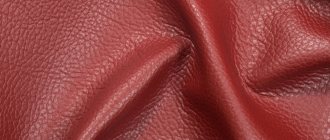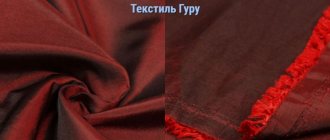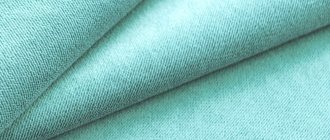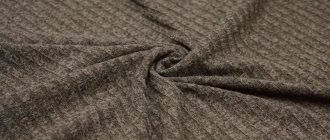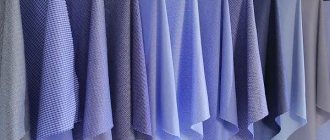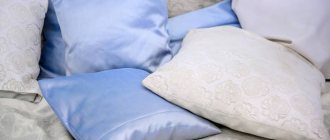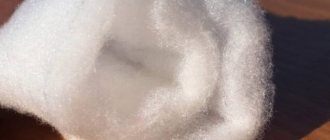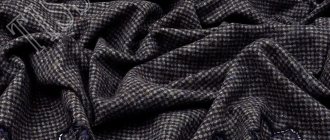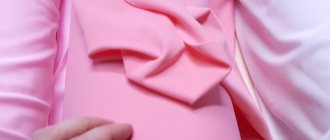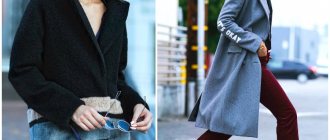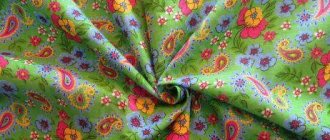Metallized fabric
This material came to the world of fashion not so long ago, but it has been used in industry for quite a long time. A very durable fabric with a characteristic metallic sheen, which has insulating properties, is indispensable in conditions of increased heat or radioactivity. But what brought this material into the world of high fashion? In order to answer this question, it is necessary to consider in more detail the composition of this fabric and its characteristics.
Compound
There are two types of metallized fabric, they differ in the manufacturing method.
The first is direct weaving from already metallized threads. Thus, the entire structure of the fabric is metallized.
The second method is to apply a thin layer of metal (usually aluminum film) to the finished canvas. At the moment, there are several variants of this technique, but scientists continue to struggle with the question of how to metallize fabric without harming the environment. For a long time, this process was carried out by soaking fabric in electrolyte solutions; it is quite simple, but very toxic. In addition, this fabric is very stiff and has a poor presentation. The method of vacuum-technical evaporation was also used, however, this method is not particularly popular, since in this case it is very difficult to control the uniform distribution of metal over the entire surface of the blade. At the moment, the most environmentally friendly method is magnetron sputtering, but this technology is not yet widespread in the textile industry.
Subtleties of care
Textiles require careful handling and compliance with the rules of care. Items made from very fine fabrics must be washed by hand. Do not twist the product to avoid creases and deformation of metallized threads.
It is recommended to wash separately from other items. The water temperature should be no higher than 40 degrees. Gels are used as detergents.
Spinning is performed at minimum speed of the washing machine drum.
It is recommended to iron the products in the “Synthetic” mode on the matte side through gauze (iron iron).
For severe, persistent stains, dry cleaning is acceptable.
Characteristics
Metallized fabric has become famous for its ability to insulate thermal and electromagnetic radiation. This material is resistant to tears, bends, stretching in places where there are breaks, and has a characteristic metallic luster. Depending on the base material, it can be either quite light and flexible, but at the same time durable, or rough and rigid, which allows it to be used for the manufacture of protective screens. Caring for such fabric must be careful so as not to damage the integrity of the outer metal coating.
Workwear
One of the main areas of use of the material is the manufacture of workwear. Thanks to its radiation protection function, metallized fabric has become a leader among other heat-resistant fabrics for sewing special uniforms for fire service workers, as well as protective suits used in industries with high temperatures, radio and electromagnetic radiation. For example, this material is widely used in hospitals. Clothing made of metallized fabric for medical personnel is used in physiotherapy departments, as well as departments of functional diagnostics.
Application
Photo gallery of lamé fabric products
Lame fabric is used in sewing the following products:
- evening dresses;
- outfits for special occasions and stage performances;
- dance costumes;
- blouses, tunics;
- skirts;
- drapes, curtains;
- bedspreads;
- tablecloths
Interior
Today, metallized fabric can also be found in interior solutions. For example, curtains made of this material reflect ultraviolet radiation, so the room remains not only darkened, but also does not heat up. In order for the curtains to perform this function, it is better to choose a two-layer product style, where on the front side a decorative fabric will be used that matches the interior of the room, but the side facing the window will be made of metallized fabric. It is this combination that will not only take care of safety, but also decorate the interior of the room.
You can also often find roller blinds with metal coating; they are quite dense, with a blackout value of 85% or higher, and are great for children's rooms, protecting not only from the sun's rays, but also from harmful radiation from the street.
In addition, household metallized fabric is used to make decorative pillows and upholstery, which allows you to create a somewhat cosmic image of the room.
Physical properties of fabrics
Optical properties include properties (color, shine, etc.) perceived by the human eye.
Textile materials have different reflectivity, which is perceived by the human eye as varying degrees of gloss. The natural shine of textile materials is a form of reflection of light by the fibers that make up the yarn and fabric. Textile fibers with a very small diameter have a significant length. Therefore, in most cases, light rays incident perpendicular to the fiber axis receive diffuse reflection, while rays directed along the fiber axis are reflected at almost the same angle (brighter reflection). The exception is cotton fibers that have a spiral crimp. Thus, the shine of textile materials depends on the direction of the light rays relative to the axis of the fibers. Most textile fibers, with the exception of glass, are optically anisotropic, that is, their structure is not completely uniform in its relation to light, which also affects the shine of textile materials. The natural shine of fabrics depends not only on the type of fibers, but also on the twist of threads and yarns, weave, the presence of pile on the surface, as well as on the nature of finishing operations.
Rayon filament yarns have a significantly higher shine than yarn made from staple fibers of the same origin. The sheen of fabric made from crepe twist yarn is less than that of fabrics made from yarn with a low twist factor. This phenomenon is explained by the fact that the rays of light, reflected from the turns lying at a large angle to the axis of the yarn, are scattered. The longer the overlap in the fabric and the fewer bends in the threads that form it, the less scattering of the incident rays of light and the greater the shine of the fabric. Therefore, fabrics with satin and satin weaves and knitwear with satin and charme weaves have the greatest shine.
In fabric finishing processes , to improve their appearance, special operations are used that increase the shine of fabrics. Thus, cotton fabrics are mercerized and calendered. When calendering, the fabric is subjected to pressure at high temperatures, resulting in a smoother and more shiny surface. Conversely, operations such as felting and combing, as a result of which randomly directed fibers appear on the surface of the fabric, reduce the shine of the fabrics and give them a dull appearance.
In the processes of wet-heat treatment during the manufacture of products, shiny spots appear in certain areas of the parts, which arise under the influence of the pressure of the press pads, temperature, humidity and exposure time to the ironing surface. The cause of shine in this case is the appearance of flat areas in the threads protruding on the surface of the fabric. The degree of gloss is determined by the relative difference in brightness of the background and the shiny spot, the so-called contrast:
where Vd is the brightness of an individual spot; Vf - background brightness.
The main factor causing lasing is the pressure of the ironing surface, especially if it is distributed unevenly over the surface of the product. The areas near the seams are usually subject to the greatest pressure, since the thickness of the product in these places is greater and the specific pressure of the ironing surface is also greater. The appearance of shine during wet-heat treatment processes worsens the appearance of the product. If the material is moistened and then dried with an ironing surface, the shine formed on the material is more stable, since the fibers are more firmly fixed in a highly compressed position. The higher the temperature of the iron, the greater the pressure of the ironing surface and the longer the period of its exposure to the fabric, the stronger the lasses. After removing the compressive load, a relaxation process begins, as a result of which the lasses may disappear over time. Since the relaxation process proceeds very slowly, to speed it up, stripping and, in some cases, stripping with the action of brushes are used simultaneously. Under the influence of steam, the fibers, relaxing, rise, the waves of threads flattened by the ironing surface restore their shape and the lasses disappear.
The ability of different fabrics to acquire lasses as a result of ironing and pressing is not the same. Laces appear faster on dense fabrics made from twisted yarn with oriented fibers and a large supporting surface. The lower the degree of movement of the fibers in combed wool fabrics, the more easily they form a flat surface with increased reflectivity. The larger the supporting surface of the fabric, the easier it is to form flat areas with increased reflectivity when ironing. Laces easily appear on wool blend fabrics with the addition of staple fiber. Steaming finished products to destroy lass partially reduces the effect of wet-heat treatment. The use of presses with spring cushions, soft gaskets, and needle-shaped surfaces reduces the pressure during pressing, and in addition, ensures its uniform distribution over the entire pressed surface, which reduces the appearance of lass.
Shine in fabrics appears during product use. Most often it occurs in combed wool fabrics and is their disadvantage. The appearance of shine most often occurs in areas of the product that are most often subject to friction with surrounding objects. On knitwear, shine is especially noticeable in areas near the seams. In all cases, shiny spots appear on dark-colored fabrics and knitwear (black, blue, purple and red) faster than on light-colored fabrics. The change in reflectivity of worn fabrics and knitwear is explained by damage to the fibers in the protruding areas of the threads. Some of the fibers near the protruding areas are cut off, as a result of which areas are created that reflect light well. The visual perception of shine is enhanced by the contrast with the general background of the fabric surface, the light from which is scattered. The appearance of shine in products during wear is an indicator of the destruction of the fibers that form the threads.
- Forward
Fashion
But this fabric has conquered the world’s catwalks not so much for its insulating and protective properties as for its appearance. For sewing clothes, they use fabric based on soft synthetic or combined weaving, less often natural fabrics. Household fabric can have either a continuous coating or a partial coating, made in the form of an ornament or classic polka dots, checks and stripes. The intensity of the shine of such fabrics also varies - from the rich shine of nickel or New Year's tinsel, to the aristocratic reflection of pearls. That is why this material is readily used both for creating festive outfits, especially relevant on New Year’s Eve, and for sewing everyday clothes, including business suits. However, even fashion designers could not completely ignore its protective properties, which is why metallized raincoat fabric is actively used for the manufacture of outerwear.
A jacket made of such material not only looks impressive, but also has heat-insulating, dirt- and water-repellent properties, and also reflects harmful radiation.
In addition, the method of fabric metallization is actively used in the manufacture of shoes and accessories: handbags, belts and gloves.
High-tech fabrics, often intended only for industrial use, fit seamlessly into the lives of ordinary people. The cosmic charm of metallic fabric will not only make a woman noticeable in any environment, but will also protect her from the harmful effects of the modern world.
Advantages and disadvantages
Fabric photo gallery
The properties of the material and its external beauty determined the main purpose of textiles. Due to its low hygroscopicity and air exchange rates, lamé is used mainly in tailoring clothes for special occasions. For everyday models, fabric is not used.
The advantages of shiny patterned fabric with metallized fibers include:
- spectacular appearance;
- softness;
- drapeability;
- color fastness;
- rich color palette;
- the ability to use any of the sides as the front side in the design.
Among the disadvantages, you need to pay attention to the following qualities:
- low air conductivity and hygroscopicity;
- Low strength;
- tendency to deform under strong tension;
- working with fabric requires skills;
- high price.
